How can we picture scale? In a text we can use descriptions filled with adjectives or comparisons to allow the reader to imagine the actual size of the object in question. However when making an image – be it in drawing or print – a series of different strategies are needed to convey size and scale. Is the drawing the same size as the actual object? Or is the drawing a smaller representation of, for example, a building? Or an enlarged depiction of what was observed through a microscope? As soon as a drawn object is not similar in size to the original, scale comes into play in the translation from object to paper. In this theme we will find images from drawing manuals, architectural and perspectival treatises as well as books on microscopy and botany.
In the book on perspective by Daniele Barbaro we see how text and image explain how one can measure certain things at a distance when the distance to the object is known. Using one’s hands as a measuring device it is then possible to make calculations about the height and width of objects such as buildings. How to then depict this naturally in two dimensions is explained in the book on perspectival practice by the French mathematician Jean Du Breuil, shown in this section. In the architectural plans by Joseph Furttenbach we see the introduction of an actual scale, a line that explains to the reader the size of the building plans in the images. The final images are from the field of microscopy, showing an instrument and it optical workings, and images on the basis of observations.
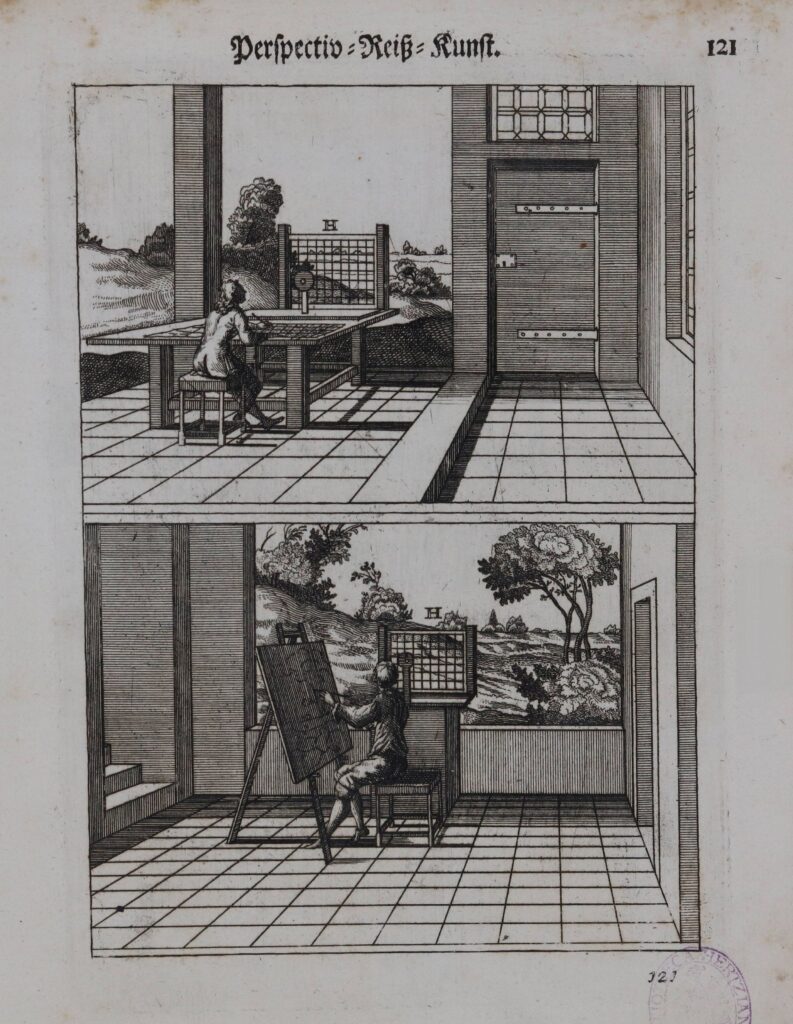
Scale is closely related to perspective, as both are employed when something needs to be depicted that is bigger than the two-dimensional visual output. We can think of a building, but also a landscape, a group of people, etc. How does one reduce the real image so that it fits onto a page? Drawing manuals from the early modern period offer plenty of possible solutions, such the as use of a grid. A grid had a double function; it could be used to reduce a life-size building or landscape to paper, but was also used to translate a smaller drawing to a full-sized painting or fresco. In these images from Jean Du Breuil’s Perspectiva practica (Augsburg 1710) we see a painter looking out towards a landscape using a grid from threads as a frame to scale objects and perspective in the distance. The artist would also draw a grid on paper and carefully compare and measure the landscape in the distance. The grid in front of the landscape and the grid on the paper, then allows the artist to depict the observed landscape with trees and hills in the correct size and scale onto the paper.
Another image from the same book gives the reader an even more telling example of how scale impacts our perception. In the top image of this page a horizon is added in the upper quarter of the image, casting the viewer’s eye to the landscape or space in front of them as from the eye level of the classical figure on the left. And thus, if the perspectival system is put in place correctly, a person of the same size as the figure in the foreground will need to be scaled down accordingly to be represented either in the middle ground or at a distance. The further away they are, the smaller the figure gets. In the bottom image the horizon line is placed towards the bottom of the image, with the figures placed directly on the line. These figures then need to have their “actual” size, as to understand their scale. Comparing the top and bottom images gives us as readers an understanding of the correlation between scale and perceived size. The figures in the top image are thus more or less of the same height in “reality,” while the figures in the lower image are of very different heights.
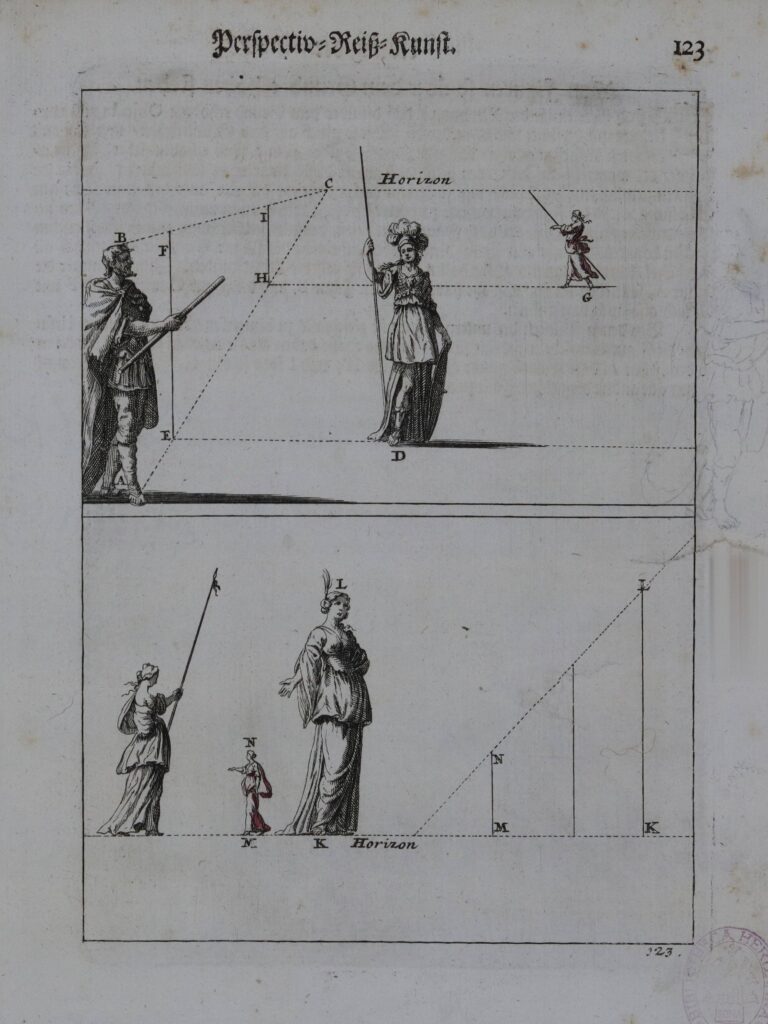
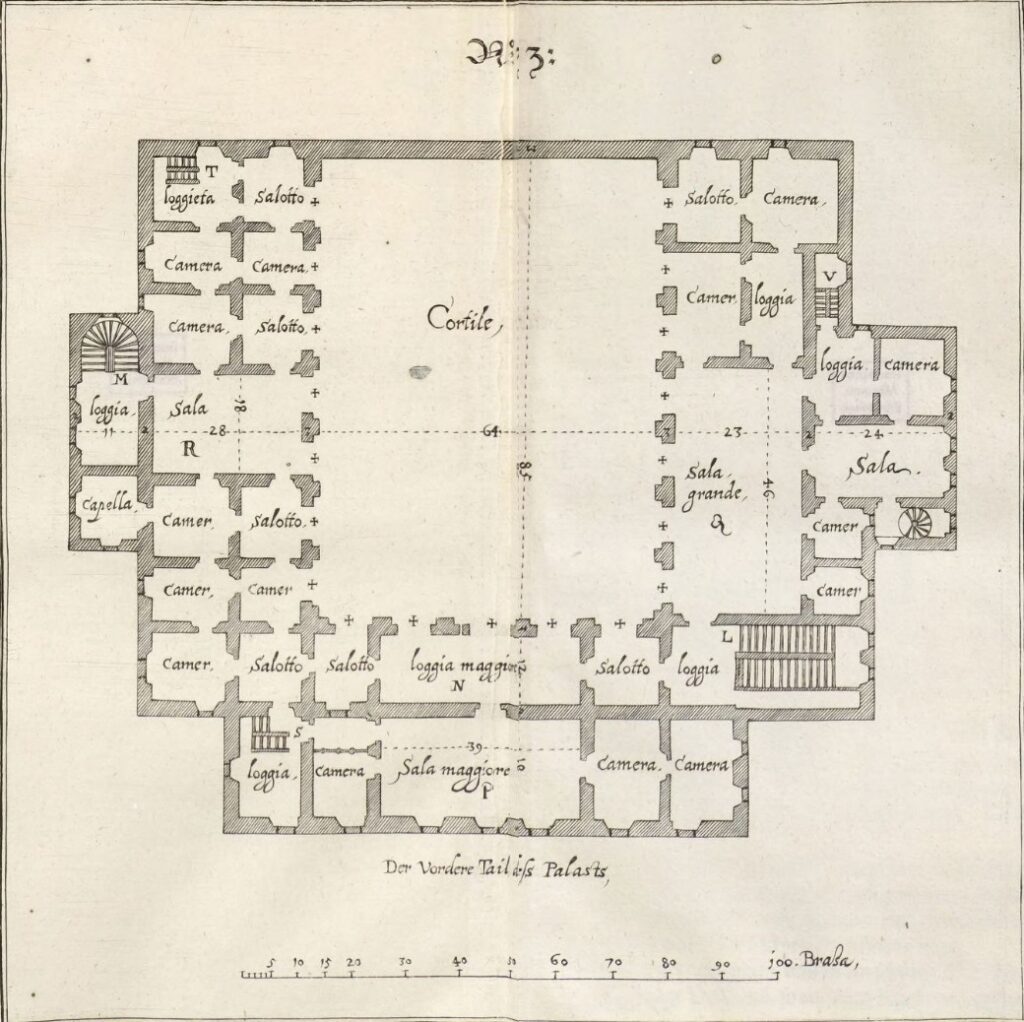
Perspective is just one way of visualizing scale. However, some other practical applications of scale require greater precision in the indication of the actual size of the depicted objects. In architectural drawings as well as maps we find another way of depicting sizes, namely by drawing to scale. By including a scale line at the bottom of his floor map of a palazzo, Joseph Furttenbach shows precisely what the scale is to which he drew this house in his Architectura civilis (Ulm, 1628). The reader then has the possibility to calculate the actual size of the house, including its grand court yard.
For studies on natural history scale was important, or was it? As a modern reader one would expect that scale became important especially with the use of microscopes in the seventeenth century. However, scale is not always easy to measure, and even more difficult to depict when it comes to insects.
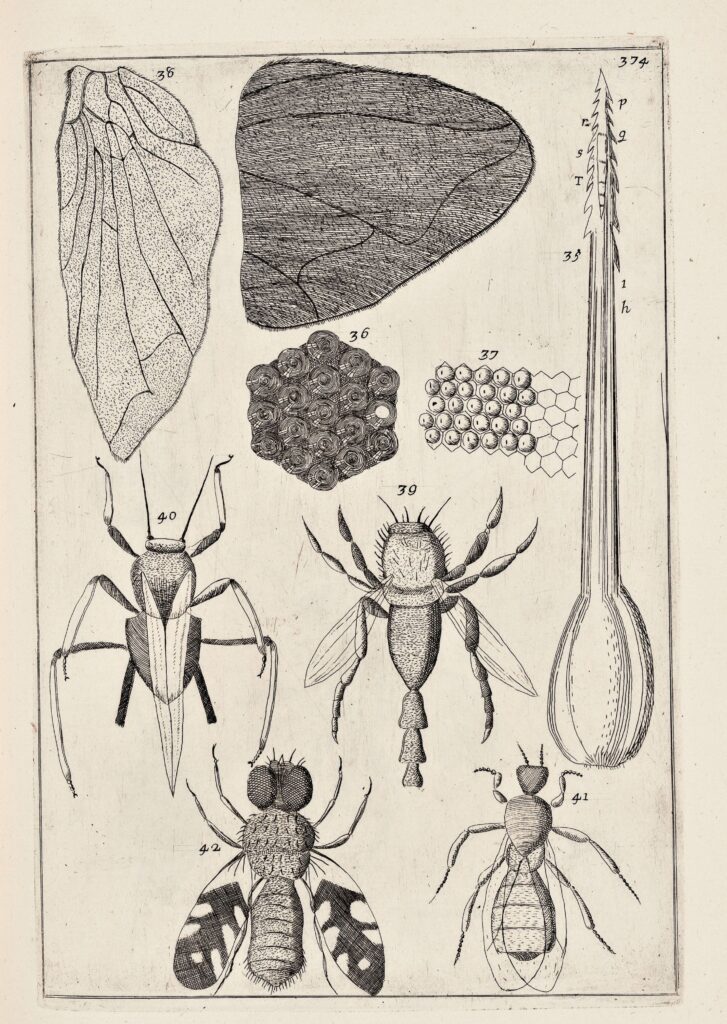
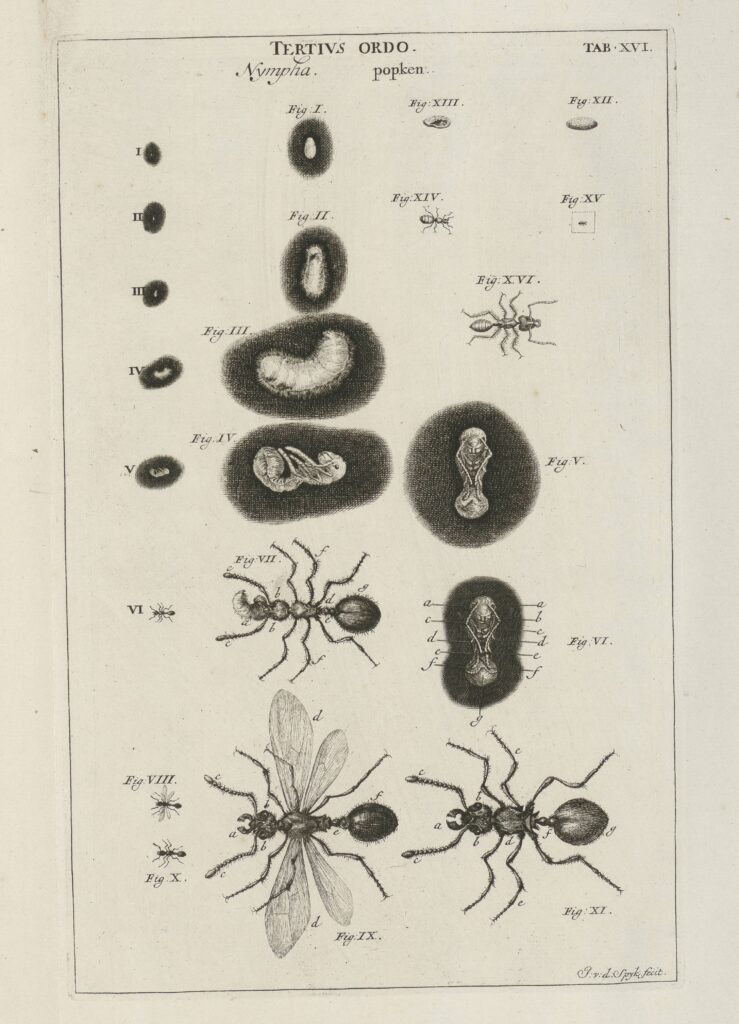
In this etching from Filippo Buonanni’s Musaeum Kircherianum (Rome 1709), we see a strange mixtures of things depicted. If everything here was indeed to scale, the world would be much scarier than it already is. Buonanni depicts here four entire insects in the bottom half of the image, and their wings, eyes, and sting in the top half. He seems totally uninterested in explaining the scale of these insects to his readers, as the enlarged insect parts in the top half lack any indication to their actual size, or even to their relative size in comparison with the insects in the bottom half of the image.
Figure number 36 is a direct copy from Robert Hooke’s Micrographia, published in London in 1665. This lavishly illustrated book on microscopic observation, became a reference book for microscopists within years of its first publication. Buonanni has also taken images from other authors, such as Johannes Swammerdam, and has put them together on one page for comparison, but not to scale. In his book Buonanni wanted to show his readers the wide variety of objects and books that Athanasius Kircher had collected, giving an overview of all the wondrous and rare items of his museum.
So different is the approach of the Dutch natural philosopher and microscopist Johannes Swammerdam, who prepared his drawings meticulously for publication, which appeared posthumously in his Biblia naturae (Leiden 1738). The detailed etching we see here, depicts various stages in the development of an ant from an egg (at the top left, figure I) to a fully grown flying ant (on the bottom left, figs. VIII and X). In this image Swammerdam provides the actual size of the ant during these various stages. His approach allowed him to present his readers the actual size, and detailed enlargements, without having to provide a scale for measurement on the page. With this visual strategy he pioneered a scientific method of depiction that was entirely novel in the 17th century.
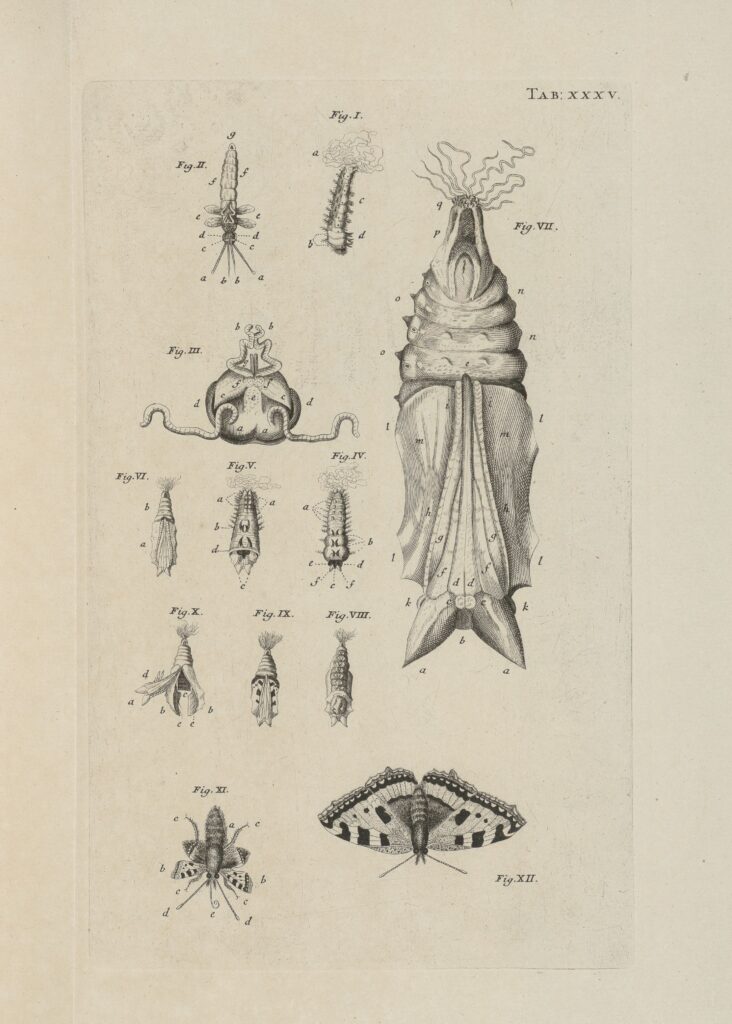
However, not all pages of images in this book followed the same visual form. On Plate XXXV, for example, he displays the pupal stage of the metamorphosis of a caterpillar into a type of butterfly. In the accompanying text he writes that he has enlarged the parts in figures III and VII. We have to deduce the real scale in comparison with the other images on the page, assuming that those were depicted to size since he did not comment any further on them. It was important for Swammerdam to mention in his text when the images were the same size as the original specimen, and when they were enlarged. Such information was integral to the interpretation of the images, allowing the images to show what would otherwise be next to impossible to see with the naked eye.
The final images in this section on scale are from a very special multi-volume work in the Hertziana collection: Mousses de la Normandie (Falaise, 1826–1833) by Alphonse de Brébisson. It contains printed descriptions of the mosses accompanied with actual specimens of the natural materials. As a result, the tomes are thick and the pages are crinkly from the humidity still present in the dried plants. This book raises questions about the depiction, representation, visualization and scale of natural objects. Benefits of including actual objects are of course that there is accurate information about scale and material. However, color quickly fades in dried plants, and only one particular stage of the plant’s life is represented instead of its entire life span, something possible to depict in a composite image. Because of the great effort to collect and paste each specimens in each copy of the book, a book with printed illustrations would ultimately have been easier. However, having the actual moss in the book gives the reader an unrivaled opportunity to see, touch, and smell all the different mosses that Normandy had to offer. With the inclusion of actual moss the necessity of providing scale in this book disappears entirely.
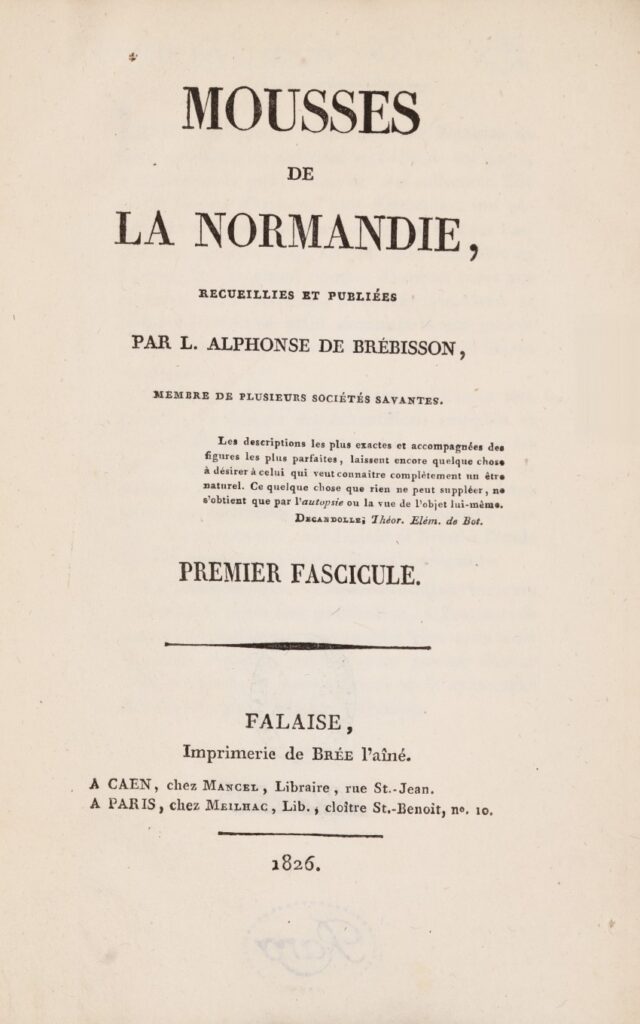
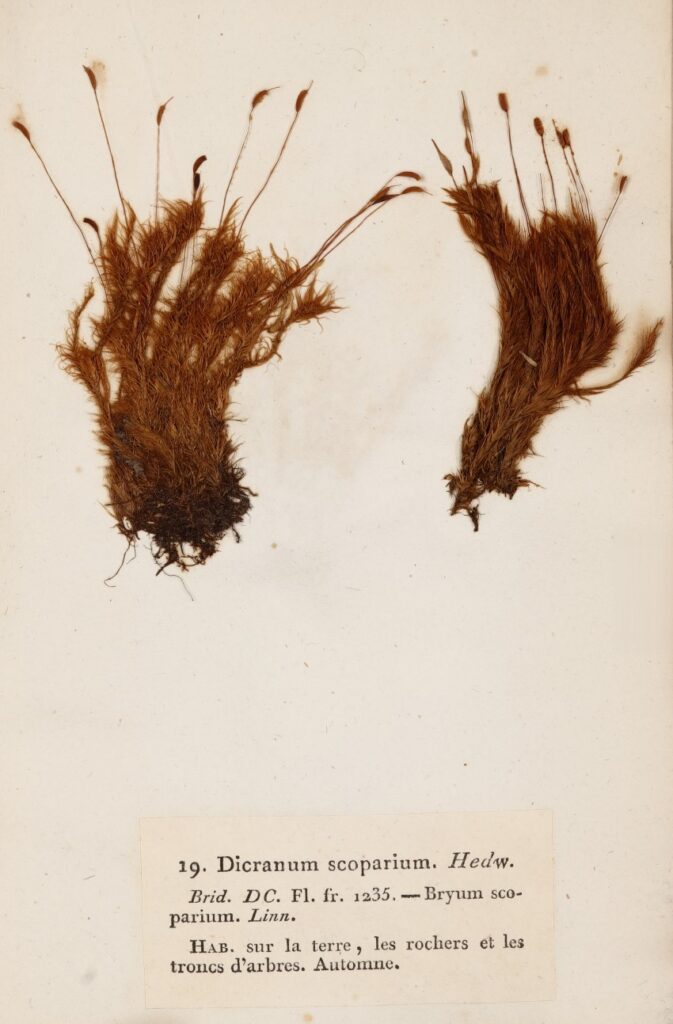
vol. I, fig. 19
Sources:
- Du Breuil, Jean. Perspectiva Practica, Oder Vollständige Anleitung Zu der Perspectiv-Reiß-Kunst … . Augspurg: Wolff, 1710. Gh-DUB 6523-3100 raro IV [Kubikat; Digitized Version]
- Furttenbach, Joseph. Architectura Civilis: Das ist: Eigentliche Beschreibung, wie ma[n] nach bester form, vnd gerechter Regul, Fürs Erste: Palläst, mit dero Lust: vnd Thiergarten, darbey auch Grotten … Ulm: Saur, 1628. BHR: Gh-FUR 7713-2280 raro VI [Kubikat; Digitized Version]
- Buonanni, Filippo. Musæum Kircherianum Sive Musæum A P. Athanasio Kirchero In Collegio Romano Societatis Jesu Jam Pridem Incœptum. Rome: Placho, 1709. BHR: KatM-ROM 105-3090 raro VIII [Kubikat; Digitized Version]
- Swammerdam, Johannes. Biblia naturae, sive historia insectorum (Leiden: Severinus, Van der AA and Van der AA, 1738. BHR: Zx 620-3370/2 raro VIII [Kubikat; Digitized Version]
- Brébisson, Alphone de. Mousses de La Normandie. Falaise, Imprimerie de Brée L’Aîné, 1826-1833. BHR: Zx 780-4260/6 raro IV [Kubikat; Digitized Version]
Further Reading:
- Eriksen, Christoffer Basse. “Magnifying the First Points of Life: Harvey and Descartes on Generation and Scale.” History of Science 60, no. 4 (2021): 1-22.
- Egmond, Florike. Eye for Detail: Images of Plants and Animals in Art and Science, 1500- 1630. London: Reaktion Books, 2017.
- Jorink, Eric. Reading the Book of Nature in the Dutch Golden Age, 1575-1715. Leiden: Brill, 2010.
- Lazardzig, Jan. Theatermaschine und Festungsbau: Paradoxien des Wissensproduction im 17. Jahrhundert. Berlin: Akademie Verlag, 2007.
- Michalsky, Tanja. “Gaining Insight Through a Bird’s-Eye View. On the Chorography of Naples in the Early Modern Era.” In Visual Engagements. Image Practices and Falconry, edited by Yannis Hadjinicolaou, pp. 272-296. Berlin/Boston: De Gruyter, 2020.
- Smith, Pamela & Paula Findlen, eds. Merchants and Marvels: Commerce, Science, and Art in Early Modern Europe: Commerce and the Representation of Nature in Early Modern Europe. New York: Routledge, 2001.